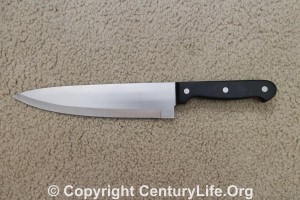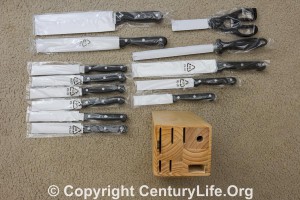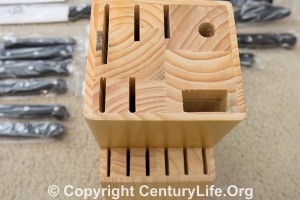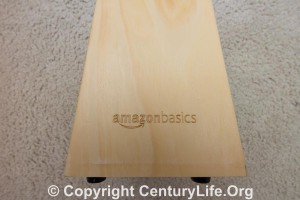INTRODUCTION
Occasionally someone will ask me to review kitchen knives. I was reluctant to do so, because what does that have to do with longevity? Knives don’t contact food that much. However, to the extent that easier cutting encourages people to cook healthy at home (instead of eating out or microwaving a TV dinner), then I’m all for getting better knives.
Affordable knives can be perfectly fine and in some cases better than expensive knives. There are great knives out there that don’t have full tangs or bolsters or forged blades, so don’t be afraid to buy them just because of outdated/untrue information about how you allegedly need to have a full-tang knife or whatever.
For example, the Victorinox 8-Inch Fibrox Chef’s Knife has an unassuming plastic handle, a stamped blade, and has a half-tang (so the metal goes only halfway down the length of the handle), but it’s a great performer in practice, anyway. In contrast, I’ve seen knives that “checked off” all the marketing boxes (forged, full tang, riveted, wood handles, etc.) but were mediocre performers. Don’t buy the marketing checkboxes; buy knife performance.
Frequently Asked Questions:
How many knives do I need?
You really only need two knives: a chef’s knife (also known as a “cook’s knife” or a Japanese gyuto–which is basically the same thing shaped differently) and a paring knife (for tasks like peeling small fruit, which you could do with a chef’s knife in theory, but it may feel awkward).
Specialty knives like bread knives, boning knives, vegetable knives (Japanese nakiris), and santoku knives (which look like chef’s knives but with a nose that curves down and a flatter profile) can make your life easier, but they aren’t strictly necessary because a chef’s knife can do a decent job substituting for any of those.
Are sharper knives more dangerous than dull knives?
No. The opposite is true. With a dull knife, you have to push harder, and if your hand slips or if the knife blade slips, that could mean cutting yourself. With a sharp knife, the knife does more of the work, so you can use a lighter touch and have more control.
Are expensive knives worth it?
Only if you value their artistry as well (see below).
Does it matter how sharp a knife is out of the box?
Not really. All knives get dull and must be re-sharpened, sooner or later. What does matter is construction (including build quality, comfort, etc.) and steel quality.
If a knife blade rusts, does that mean it’s not good steel?
It’s usually the other way around. The addition of elements like carbon harden the steel but also lower the corrosion resistance. Just wipe your blades dry after each session, and never run them through the dishwasher.
What about serrated knives?
Cheap knives and certain knives like bread knives are serrated to better tear apart a tough-skinned food. However, serrated knives don’t do as well on chopping/mincing tasks and can be harder to sharpen. You can use a hand-held sharpener but the teeth will get worn away eventually. I would not use a serrated knife as my main chef’s knife, but as a specialty knife (e.g., tomato knife, bread knife, etc.). Rarely-used, often-abused knives like steak knives can also be serrated; guests are going to abuse them by cutting on hard ceramic plates and such, anyway.
What’s a tang/bolster/forged blade/etc.?
See the Glossary.1
A QUICK GUIDE TO RECOMMENDED KNIFE SETS AND STORAGE
There are three paths you can take when it comes to knives: high cost, medium cost, and low cost:
High Cost: This is the realm of $200+ Japanese knives. They are often very hard and can thus take a very acute (narrow angle) edge. They are more like works of art that can also be used as kitchen cutlery, rather than the other way around. If you want to buy these for artistic or collectible reasons, go for it, but no matter how hard they are, they eventually get dull just like any other knives, so you have to sharpen them. Sharpening the exotic steels can be cumbersome as some are prone to chipping or are too hard for conventional sharpening steels. These exotics are overkill for most residential kitchens, so I won’t address them further, but I can definitely understand why some people love the artistry of high-end Japanese knives.
Medium Cost: If you think your knives may be abused (not by you of course, but by housemates who don’t wipe dry your knives after each session), then skip down to “Low Cost” below for a cheap-and-easy solution. Otherwise, I would highly recommend getting one of the medium-cost knives below.
Medium cost knives are generally made in Europe or Japan (Western and Japanese knives). The Western knives tend to be heavier, with soft stainless steel. Japanese knives tend to be lighter, with harder steels.
Harder steels can hold acute (narrow angle) edges better: whereas Western knives are often 40-degree (20 degree angles on each side of a symmetric edge), Japanese knives can go to 30 degrees or lower. More acute angles usually mean easier cutting. You might think then that you would want the hardest steel possible, but harder steels are often more brittle and less corrosion-resistant, which means a higher risk of chipping and rusting.
The two knife brands I would most recommend in the medium-cost category are Tojiro DP and Global. Both are made in Japan and offer a good balance between steel hardness and corrosion resistance/resistance to chipping, and both use acute edges for easier slicing and chopping:
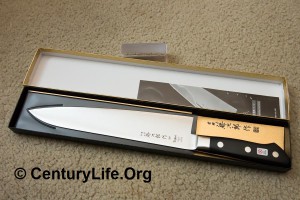
Tojiro DP
The best bang for the buck is the Tojiro DP series (the chef knives have blades 21, 24, and 27 cm long, or about 8, 9.4, and 10.6 inches long; some sellers list the length of the boxes, which is silly). Tojiro DP knives utilize a thin core of VG-10 steel, surrounded by softer steel to absorb scratches and impacts. (The VG-10 is exposed only at the knife’s cutting edge.)
VG-10 is much harder than typical German steels (think Henckels and Wusthof), so it’s easy for VG-10 to take acute edge angles. Tojiro DP blades ship with edge angles of roughly 15 degrees on each side, which helps cut more easily than the 20-degree German knives. You can go even harder than VG-10, but you run into more and more issues (having to find harder sharpening steels/ceramic rods, chipping, etc.). So VG-10 is a good sweet-spot steel that balances all those variables.
The construction and fit and finish of the Tojiro DPs are pretty good, with full tang and laminated wood-resin handles, so you will have no worries about knife longevity. Tojiro DPs don’t have bolsters (metal ridges) that go down to the knife edge, so they are easy to sharpen. I recently replaced my Tojiro 8 inch gyuto (Japanese chef’s knife) with a Tojiro DP 9.4-incher (pictured above). The 8-incher was just fine, but the 9.4-incher can cut more food in one pass. Stick with 8-inch knives if you have small to medium hands.

Global
If you have smaller hands or plan to use your knife for hours each day, then I’d recommend Global knives made in Japan by Yoshikin. A cooking instructor recommend Global knives to me back in the day, so I got a Global G-2 20 cm (~8-inch) chef’s knife and loved it. Global knives are favorites among professional chefs because they are lightweight and handle well, in part due to the hollow handle filled with sand (for better balance). The metal handle isn’t as slippery as it looks, because the dimples help your palm’s grasp. Global knives are ~20% harder than typical Western stainless knives and are sharpened to ~30 degrees (15 degrees on each side) for cleaner cutting than typical ~40 degree Western knives. Global knives have no bolster and are relatively easy to sharpen; the company even makes MinoSharp
hand-held sharpeners specifically for its own knives. (There’s also the less-fancy Global Speed Sharpener GSS-01
if you don’t mind slightly rougher sharpening.) I would take a Global chef’s knife over any Western chef’s knife any day.
Higher-priced knives like Globals are often counterfeited.2 To avoid such scams, I would recommend buying them from reputable retailers.
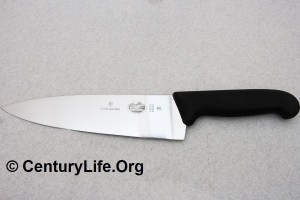 Victorinox/Forschner (honorable mention)
Victorinox/Forschner (honorable mention)
Victorinox/Forschner’s ever-popular Victorinox Fibrox 8-Inch Chef’s Knife 40520, 47520, 45520, 5.2063.20 is a great value, though I’d also recommend the Tojiro DP 8-inch gyuto
–the Tojiro is sturdier and uses harder steel that can hold an edge longer. I’d get the Victorinox chef’s knife on a budget if you’re ok with sharpening it more often. (However, the Victorinox paring knife
is a steal, and I would recommend getting that over the much costlier Tojiro DP 3.5-inch Paring Knife
and Global GS-38 – 3 1/2 inch Paring Knife
which each cost over $40.)
Victorinox knives are made in Switzerland and have decently-comfortable plastic handles and stamped blades. They are slightly on the lighter side by Western knife standards, but not so light as to impair their functionality. They have no bolster, making them easy to sharpen, and use typical German-style stainless steel but heat treated so it’s harder than you might expect. Although the knife is half-tang (so the blade tapering off into a metal tail goes only halfway down the handle), that’s enough to endure even the heaviest kitchen abuse. The handle is made out of anti-slip Fibrox plastic. They handles aren’t elegant, but they get the job done.
These knives are factory sharpened at 30 degrees (15 on each side), unlike most Western knives that are at 40 degrees. The narrower angle makes for somewhat easier cutting. If you want to use a hand-held sharpener, you can’t use ones designed with 40-degree knife edges in mind; instead, use this instead: Smith’s 50264 Adjustable Manual Knife Sharpener
Kyocera Ceramic Knives (honorable mention)
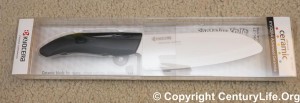
High-quality ceramic knives like the Kyocera Revolution 3-Piece Ceramic Knife Set or Kyocera FK-200WH-BK Revolution Series Professional Chef’s Knife, 8-Inch
are viable options. Ceramic is much harder than steel and requires special knife sharpeners like the Kyocera Electric Diamond Knife Sharpener for Ceramic Knives
. Ceramic knives never rust, and produce doesn’t oxidize as fast when cut with ceramic.
However, ceramic can chip or fracture, so don’t do things like try to cut bone with them. Don’t even think about buying these if you have household members who do things like toss knives into drawers without knife protectors, because all that banging around means inevitable chipping. I resort to keeping my Kyocera ceramic knife in the plastic box it came in, for fear that a guest or household member may slam its delicate edge into another knife.
Kyocera (a name derived from “Kyoto” and “Ceramic”) is a Japanese manufacturer that warranties its ceramic blades for life, but you lose access to your knives during shipment, and it’s not clear to me who pay for shipping (each pays her own? Kyocera pays both ways?). But it’s better than the dubious ceramic quality and warranties you get from many other sellers.
Whether you get a Global, Tojiro DP, or another medium-cost knife, you will want to wipe them dry after each use to avoid rust, and you will want a knife storage device of some sort. I would recommend buying either a wood-covered magnetic knife strip or a traditional wooden knife block (see below).
Low Cost: Get a large set of knives with knife block and a cheap hand-held sharpener for $40 total. Here’s how: Get the AmazonBasics 14-Piece Knife Set with Block and the Smith’s JIFF-S 10-Second Knife and Scissors Sharpener
. That’s all you need. If the blades rust, just BKF the rust off, but they shouldn’t rust as long as you don’t run them through a dishwasher. Wipe them dry soon after each use to further guard against rust.
PROS:
- Dirt cheap price.
- Can take a sharp edge, indicating decent steel (sharpness out of the box is ho-hum; give it a few passes on the knife sharpener first, and you can get it sharp enough to easily slice copier paper)
- Decent construction won’t fall apart unless abused.
- Resistant to other household members abusing your knives–and if they break them, you can replace them for cheap.
CONS:
- Due to softer steel, you’ll need to resharpen knives more often
- Softer steels are unable to take more acute edge angles, so they won’t cut as cleanly as more expensive Japanese knives.
- The knife edge’s bevel doesn’t slowly taper up to the spine of the knife, resulting in more resistance when cutting things like onions.
- Knife handles are often a little undersized and plastic and thus not comfortable for large hands.
- The knife block is built at a steep angle, so you won’t be able to get knives out of it if you put the block underneath a cabinet, unless you sit the knife block on its side.
I came across the AmazonBasics 14-Piece Knife Set with Block while looking for steak knives. The knives are not high-end, and you will have a smoother time cutting with any of the medium-cost knives (above). But you get a lot of bang for the buck: you get an 8-inch chef’s knife, a 3.5-inch paring knife, an 8-inch slicing knife, an 8-inch bread knife, a 5.5-inch utility knife, six 4.5-inch steak knives, scissors, a honing/sharpening steel, and a wood knife block. And if you ever decide you want a better chef’s knife and/or paring knife, you can replace the ones in this set with the medium-cost knives (above) and keep the rest, most of which will still be useful (e.g., the wood block, scissors, steak knives, and bread knife).
The knives have an unsharpened area near the heel that will jut out more than the rest of the blade, if you sharpen everything except that area. If the jutting happens, it prevents full contact of the blade to the cutting board. So run that part of the knife through a hand-held sharpener a bunch of times, if necessary. If you fall way behind on sharpening that part of the knife, then take a wad of sandpaper or electric sander to it and finish off with a hand-held sharpener.
Speaking of hand-held sharpeners, whenever you find an AmazonBasics knife getting dull, just give it a few light swipes with the Smith’s JIFF-S 10-Second Knife and Scissors Sharpener, which can take a knife from dull to acceptably sharp in 10 seconds. You just hold a knife against a table, edge-side-up and swipe the sharpener along the blade a few times. The drawback is that the sharpener takes off more steel than necessary, which shortens the lifespans of your knives. But this isn’t a big drawback when used with cheap knives that are cheap to replace.
If you’re looking for alternatives to the Smith’s JIFF-S sharpener, the Smith’s CCKS 2-Step Knife Sharpener is a cheaper Smith’s handheld sharpener that also works, but it isn’t as stable to hold and can’t sharpen scissors. The AccuSharp 001 Knife Sharpener
is another popular handheld knife sharpener, but it can’t sharpen scissors, so I recommend the Smith’s instead. I would get either the Smith’s or Accusharp over any electric knife sharpener, because a) the hand-held knife sharpeners are cheaper, and b) the hand-held models do a fine job, remove less steel, and don’t add as much clutter to your home.
NOTE: If you have a knife with a 30-degree edge (like the Victorinox 8-Inch Fibrox Chef’s Knife, Global G-2
,or the Tojiro DP series
which is technically a little narrower than 30 degrees but which can be sharpened at 30 degrees with no ill effects), you will need a sharpener that can deliver 30-degree angles (15 per side) such as the Smith’s 50264 Adjustable Manual Knife Sharpener
.
KNIFE STORAGE

As far as knife storage goes, you have a lot of options:
Wooden/Bamboo Block: traditional, doesn’t tip over that easily, but requires some space above the block, so you probably can’t use these very well under low-hanging cupboards. Wood can absorb any remaining water that may be on the blades. Good knife blocks have horizontal slits so that you don’t wear down the edges faster by having them “cutting” wood/bamboo when at rest (via the force of gravity).
Plastic Flex-Rod Block: These utilize many little rods of plastic, and in theory they are universal in the sense that you can plunge whatever size knife wherever you want. The downside is that the rods will get cut and eventually break over time, and particularly large (wide or long) blades may not fit. They also need space above the block, so you probably can’t use these very well under low-hanging cupboards. Plastic also doesn’t help absorb water.
Magnetic Strip (Bare): These strips are screwed into walls. Benefits include freeing up counter space that would otherwise be taken up by a knife block, low cost, and the ability to show off your knives. Downsides include the possibility of a child or pet cutting himself or herself, depending on where the strip is mounted. It’s possible to chip knife edges on these strips. Avoid skimping too much on magnetic knife strips. A failed mount or magnet could mean that your strip and/or knives fall off and lead to injury of children or pets.
Magnetic Strip (Wood Covered): Same as bare magnetic strips, but without the downside of chipping your knife edges. They also look more traditional and attractive and can be a good aesthetic addition to your kitchen. Above is the best-selling 12-inch Walnut wood knife block from M.O.C. Woodworks, made in USA. They offer 12-inch knife strips in other woods, so you can choose based on color and grain. You can buy additional 12-inch strips to expand if necessary. Alternatively, the Jonathan Alden company sells 12 to 24 inch Walnut strips
and a 16-inch Cherry strip
, which is also made in USA like M.O.C.’s strips.
Avoid skimping too much on magnetic knife strips: if the mount or magnets are poorly-fastened, or the magnets are too weak (as is the case with most cheap wooden knife strips), your knife strip and/or knives could fall off and injure children or pets. And after what happened to Lumber Liquidators (which contracted with a Chinese factory that delivered off-spec wood loaded with formaldehyde, which increased consumer cancer risks), I’d be cautious about buying any wood made overseas that comes into contact with kitchen knives or any other instruments that contact your food. Stick with reputable brands in such cases.
In-Drawer: These take up less space on the countertop, but they take up more space in drawer. They keep knives out of view and perhaps out of prying kids/pets (when coupled with a safety drawer lock). The main drawback with these types of blocks is how they are unable to accommodate wider knives, and the knife blades will wear down faster because the knives are being stored edge-down onto hardwood or (most likely) bamboo. (Bamboo is actually a very hard grass and is harder on knife edges than most wood.3)
Metal Knife Block: Just don’t do it. Any knife block where your knife blades can make contact with metal is bad, because you’ll bang or scrape knife edges against metal sooner or later, sliding knives in or out of the slots and wearing down your knife edges. Small knives won’t fit well. You also can’t store particularly long or wide knives.
Novelty/Plastic: Cute, but these can tip over, and the plastic material isn’t built to last. These novelty knife stands are also expensive for what they are.
KNIFE SHARPENERS
I mentioned some cheap, hand-held knife sharpeners above, but here’s more information:
Model-Specific Knife Sharpeners
Some knifemakers make sharpeners specifically for some models of their knives, such as Global’s MinoSharp system for Global knives. I used to have a Global G-2
chef’s knife with Minosharp ceramic knife sharpener and they worked well together. However, model-specific knife sharpeners might not be useful for any other model or brand. And if your knife is a typical Western knife with 40-degree cutting edge, then you can just get a cheap hand-held knife sharpener instead (see below).
Cheap Hand-held Knife Sharpeners
A lot of people don’t want to spend the time to learn how to hone and sharpen a knife with a rod or whetstone. There is no shame in wanting a quick and easy solution such as a hand-held knife sharpener. I recommend the Smith’s JIFF-S 10-Second Knife and Scissors Sharpener, which can take a knife from dull to acceptably sharp in 10 seconds. You just hold a knife against a table, edge-side-up and swipe the sharpener along the blade a few times. There is a separate sharpener for scissors as well, built into the handle of the device.
The drawbacks to using hand-held sharpeners:
- Hand-held sharpeners remove more steel than necessary. However, if you think about it, that’s not that big of a drawback unless you use particularly expensive knives, because a) you save money on having to buy higher-end sharpeners, and b) you may save quite a lot of time on sharpening, and time is valuable too. For instance, it takes long enough to set up an Edge Pro that I wind up using my Sharpmaker instead–and for cheap knives I just use a hand-held sharpener.
- Hand-held sharpeners won’t give you as perfect of an edge as you’d get from other methods, but they’ll give you an adequate edge for kitchen cutlery. Even perfect edges quickly lose that perfection in a busy kitchen, anyway. And besides, we’re not samurai looking to slice through armor. If you need a lightsaber-like knife to cut your food, you may want to consider a change in your diet. Like eating fewer rocks.
If you’re looking for alternatives to the Smith’s JIFF-S sharpener, the Smith’s CCKS 2-Step Knife Sharpener is a cheaper Smith’s handheld sharpener that also works, but it isn’t as stable to hold and can’t sharpen scissors. The ceramic rods are not really necessary for kitchen knives, either; you don’t need kitchen knives to be that finely sharpened, since it will quickly lose the extra-fine edge anyway. The AccuSharp 001 Knife Sharpener
is another popular handheld knife sharpener brand, but it can’t sharpen scissors like the Smith’s, so I recommend the Smith’s instead. I would get either the Smith’s or Accusharp over any electric knife sharpener, because a) the hand-held knife sharpeners are cheaper, and b) the hand-held models do just as good of a job while removing less steel.
NOTE: If you have a knife with a 30-degree edge (like the Victorinox 8-Inch Fibrox Chef’s Knife, Global G-2
,or the Tojiro DP series
which is technically a little narrower than 30 degrees but which can be sharpened at 30 degrees with no ill effects), you will need a sharpener that can deliver 30-degree angles (15 per side) such as the Smith’s 50264 Adjustable Manual Knife Sharpener
.
Whetstones
Freehand sharpening on a whetstone is a time-honored tradition, but a lot of people don’t want to climb the learning curve, and that’s okay. You have to be careful not to scratch your blade against the stone, and hold it at consistent angle. If you are good at freehand sharpening, you probably already have a stone, so just keep using it and replace if necessary.
Honing and Sharpening Steels
Honing steels aren’t that hard and are supposed to straighten out deformations/misalignments on already-sharpened edges.
Sharpening steels are harder, and many kitchen knife sets come with one. If you rub a knife against it, you take off metal. Rub it along the edge at the correct angle, while simultaneously drawing the knife horizontally (so that you rub the entire length of the knife edge), and you just sharpened your knife. It takes some getting used to, which is probably why many people give up and resort to using cheap hand-held sharpeners (see above). There’s no shame in doing that, but it can get expensive since those cheap sharpeners take off more steel than necessary.
If you’re looking to buy a sharpening steel a la carte, it can be tricky to find something hard enough to sharpen your knives quickly, but not so hard so as to remove unnecessarily large amounts of metal. That’s because knives come in varying degrees of hardness. Also, you want a steel/ceramic rod that is at least as long as your longest non-serrated knife, as that allows you to draw your knife vertically and horizontally at the same time, sharpening the entire length of the blade in one motion. (Serrated knives can’t be sharpened on typical steel/ceramic rods.)
For Western knives (Henckels, Wusthof, etc.) that come with softer steels, I’d get the Wusthof 10-Inch Sharpening Steel.
For Japanese knives, I’d get a ceramic rod like the Kyocera CSW-18-BK 9-Inch Ceramic Steel Sharpener (for 9 inch chef’s knives or shorter) or the Lansky 8 Inch Ceramic Sharp Stick
(for 8 inch chef’s knifes or shorter).
Precision Knife Sharpeners (Guided Stone Sharpeners)
If you don’t want to remove unnecessarily large amounts of metal from your knives, but using a sharpening steel/ceramic rod/whetstone freehand does not appeal to you, then I recommend the Spyderco Tri-Angle Sharpmaker Knife Sharpener 204MF, which I personally use on knives I care about. The Sharpmaker has brass rods to protect your hand from getting cut, just in case your knife slips. It can also sharpen serrated knives. The set comes with an instructional DVD video, but it’s so simple to use that you don’t really need it. Basically the system relies on human instinct and gravity to slice vertically downward, and provides a brace for the rods to rest at a 15 or 20 degree angle–your choice. Common knives sold in the USA and EU (Henckels, Wusthof, and lesser-known brands) tend to be 20 degrees on each side of the blade; Japanese knives tend to be 15 degrees on each side. Thus if you simply slice downwards, the Sharpmaker gives you an angle that matches your knife.

The Sharpmaker works surprisingly well and fast. You can buy various rods, ranging from diamond-dust covered to ultra-fine ceramic, but the rods that come with the basic set are all you really need for kitchen cutlery re-sharpening. If you sharpen a knife, you want to start off with the coarser grit and then move to the finer one, such as going from the Sharpmaker’s default Medium and Fine stones (800 grit and 1200 grit, respectively–the lower the number, the coarser and thus the more metal removed.) For kitchen knives, just use the Medium stones, as you don’t really need anything finer since an extra-fine edge won’t last long on a heavily-used kitchen knife. (Sharpmaker’s diamond-dust rods are good for those who want to reprofile a very dull knife or perhaps to re-do a 40-degree knife to make it into a 30-degree knife.)
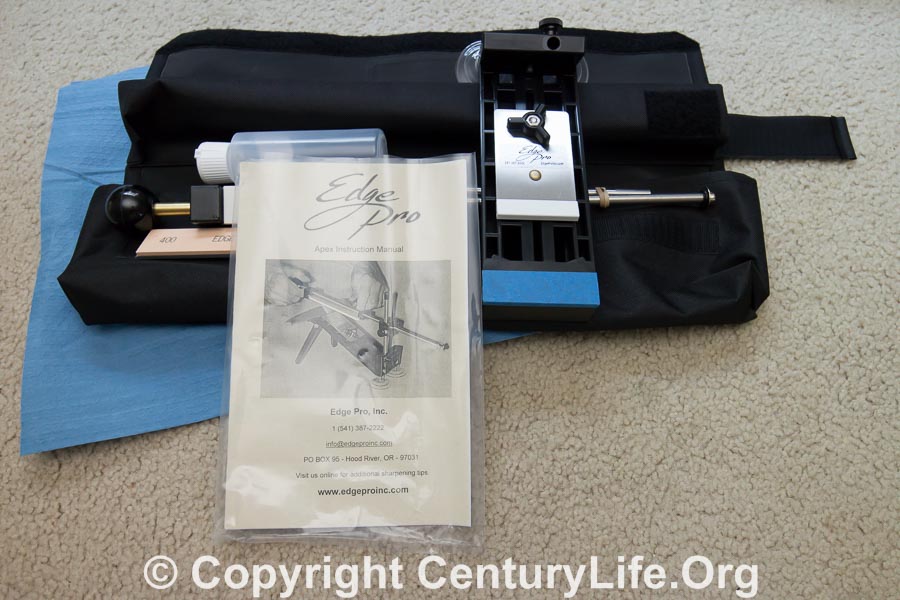
If you want to have even more control over sharpening angle, I recommend the Edge Pro Apex, bundle numbers 1 through 4. The bundle number indicates how many extra stones and accessories you get; I would just get the most-basic bundle, the Edge Pro Apex 1
, for kitchen cutlery. It comes with 220 and 400 grit; you can probably just use the 400 grit stone. (Edge Pro Professional
setups also exist; they are more durable and have clamps, but at $500+ I wouldn’t recommend them to anyone other than knife enthusiasts/professionals, especially when the Edge Pro Apex is already very durable. Also, beware Chinese imitation Edge Pro systems that use low-quality stones and aren’t as well constructed.)
The Edge Pro Apex literally helps you hold a knife at a consistent, arbitrary angle for every stroke; you aren’t limited to pre-set angles. It sounds good in theory, and it might help create a sharper edge than you’d get from freehand sharpening on a whetstone, but there’s little point in making a kitchen knife “scary sharp,” since it will dull from that level of sharpness pretty quickly on a cutting board. Therefore my Edge Pro Apex gathers dust because it takes more time to set up and use than the Sharpmaker, which does a fine job on cutlery. And for my really cheap knives, I just use cheap handheld sharpeners anyway, to save wear and tear on my sharpening steels and Sharpmaker and Edge Pro stones.
What we use in our own kitchen
We have a combination of Tojiro DP, Shun
, Calphalon
, Cuisinart
, Global
, and Victorinox
knives, and I can vouch for all of those to be good. Right now we mainly use the knives/sharpening steel/scissors from Ann’s Victorinox 8-Piece Knife Block Set
, along with some individual Victorinox knives she picked up (the Santoku
and tomato
knives), a Tojiro DP Gyutou – 9.4″ (24cm)
(comparable to a chef’s knife), a Zhen 8-Inch Cleaver
(a Chinese-style cleaver not for use as a bone-cutter, but more like a giant chef’s knife that I use for things like butternut squash; I can vouch for the Zhen VG-10 cleavers as being good, but skip the rest of their knives because they are priced too high compared to Tojiro DP), and an Update International Cleaver
(cheap sacrificial blade for hacking through bones; a softer steel is actually better for this than harder steels since harder steels will chip).

As for our main knife block, I had a hard time finding a knife block that could fit my Zhen 8-Inch Cleaver, which is 4 inches wide. One of the few knife blocks that claims to have a ~4 inch wide slot is the Shun 22-Slot Bamboo Knife Storage Block
, but when I got it, I was disappointed to find that its cleaver slot is just a touch too narrow for the Zhen. To fix the block, I bought a bow saw (with detachable blade)
and merged the cleaver slot and the adjacent slot. You could do this with other knife blocks, too; just get a block that has two slots that would be wide enough if merged, and cut the wood separating those slots.
FOOTNOTES
